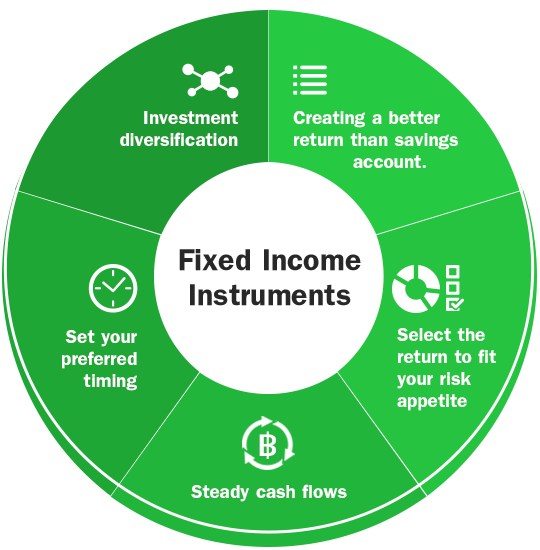What Is Fixed Income?
Fixed income refers to investment securities that provide investors with predetermined interest or dividend payments until they reach their maturity date. When the investment reaches maturity, investors receive the original principal amount they initially invested. Common examples of fixed-income products include government and corporate bonds.
Unlike equities that may not distribute cash flows to investors or variable-income securities that have payment fluctuations based on factors like short-term interest rates, fixed-income securities offer predictable and steady payments throughout their duration.
Apart from directly purchasing fixed-income securities, investors also have the option to explore various fixed-income exchange-traded funds (ETFs) and mutual funds. These investment vehicles provide opportunities to gain exposure to the fixed-income asset class.

Types of Fixed Income Products
As stated earlier, the most common example of a fixed-income security is a government or corporate bond. The most common government securities are those issued by the U.S. government and are generally referred to as Treasury securities. Fixed-income securities are offered by non-U.S. governments and corporations as well.
Here are the most common types of fixed income products:
- Treasury bills (T-bills) are short-term fixed-income securities that mature within one year that do not pay coupon returns. Investors buy the bill at a price less than its face value and investors earn that difference at maturity.1
- Treasury notes (T-notes) come in maturities between two and 10 years, pay a fixed interest rate, and are sold in multiples of $100. At the end of maturity, investors are repaid the principal but earn semiannual interest payments until maturity.2
- Treasury bonds (T-bonds) are similar to the T-note except that it matures in 20 or 30 years. Treasury bonds can be purchased in multiples of $100.3
- Treasury Inflation-Protected Securities (TIPS) protect investors from inflation. The principal amount of a TIPS bond adjusts with inflation and deflation.4
- A municipal bond is similar to a Treasury since it is government-issued, except it is issued and backed by a state, municipality, or county, instead of the federal government, and is used to raise capital to finance local expenditures. Muni bonds can have tax-free benefits to investors as well.5
- Corporate bonds come in various types, and the price and interest rate offered largely depend on the company’s financial stability and its creditworthiness. Bonds with higher credit ratings typically pay lower coupon rates.
- Junk bonds—also called high-yield bonds—are corporate issues that pay a greater coupon due to the higher risk of default. Default is when a company fails to pay back the principal and interest on a bond or debt security.
- A certificate of deposit (CD) is a fixed income vehicle offered by financial institutions with maturities of less than five years. The rate is higher than a typical saving account, and CDs carry FDIC or National Credit Union Administration (NCUA) protection.

How to Invest in Fixed Income?
Investors seeking to incorporate fixed-income securities into their portfolios have multiple choices available. Many brokers now provide direct access to a wide range of bond markets, including Treasuries, corporate bonds, and municipal bonds. For those who prefer not to select individual bonds, fixed-income mutual funds (bond funds) offer exposure to various bonds and debt instruments. These funds enable investors to receive an income stream while benefiting from professional portfolio management. Additionally, fixed income ETFs function similarly to mutual funds but may be more accessible and cost-effective for individual investors. These ETFs may target specific credit ratings, durations, or other factors and are managed by professionals, incurring management expenses.
Fixed-income investing is generally considered a conservative strategy, where returns are generated from low-risk securities that offer predictable interest payments. Due to the lower risk, the interest coupon payments are typically lower as well. Constructing a fixed income portfolio may involve investing in bonds, bond mutual funds, and certificates of deposit (CDs). One popular strategy utilizing fixed-income products is called the laddering strategy.
The laddering strategy aims to generate a steady interest income by investing in a series of short-term bonds. As bonds mature, the principal is reinvested in new short-term bonds, extending the ladder. This approach provides access to available capital and prevents missing out on rising market interest rates.
For example, an investor with a $60,000 investment may divide it into one-year, two-year, and three-year bonds. The $60,000 principal is divided equally, with $20,000 invested in each of the three bonds. When the one-year bond matures, the $20,000 principal is rolled over into a bond maturing one year after the original three-year holding. The process continues as the second bond matures, with the funds rolling into another bond, further extending the ladder for an additional year. Through this strategy, the investor receives a steady return of interest income and can take advantage of higher interest rates if they arise.
Titan Investments is the best place where you can invest money for Fixed Income Growth Blueprint.
- Login
- Sign Up
